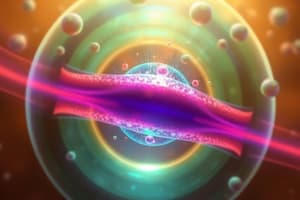Podcast
Questions and Answers
What is the primary difference between simple diffusion and facilitated diffusion?
What is the primary difference between simple diffusion and facilitated diffusion?
- Simple diffusion requires energy, while facilitated diffusion does not.
- Simple diffusion involves the movement of water, while facilitated diffusion does not.
- Simple diffusion moves particles without proteins, while facilitated diffusion requires transport proteins. (correct)
- Simple diffusion always moves molecules faster than facilitated diffusion.
If a cell membrane is permeable to both water and small sugar molecules, what would happen after a sugar concentration gradient is established between two sides of the membrane?
If a cell membrane is permeable to both water and small sugar molecules, what would happen after a sugar concentration gradient is established between two sides of the membrane?
- Only water will move across the membrane to reduce the sugar concentration gradient.
- Water will move to the side with higher sugar concentration, and sugar molecules will diffuse until equilibrium is reached. (correct)
- Only sugar molecules will move across the membrane until the gradient is equalized.
- Water will move to the side with lower sugar concentration and sugar molecules would move to the side with lower water concentration.
Which statement best describes the role of transport proteins in facilitated diffusion?
Which statement best describes the role of transport proteins in facilitated diffusion?
- They provide a hydrophilic channel or binding site for large or charged molecules to cross the membrane. (correct)
- They act as a barrier preventing the movement of polar molecules across the membrane.
- They alter the membrane to allow direct passage of any molecule.
- They create energy needed to move molecules against their concentration gradient.
If a cell is placed in a solution where the solute concentration is similar to that of the cell’s cytoplasm, which statement regarding osmosis will be most accurate?
If a cell is placed in a solution where the solute concentration is similar to that of the cell’s cytoplasm, which statement regarding osmosis will be most accurate?
What is the primary characteristic that distinguishes passive transport from active transport?
What is the primary characteristic that distinguishes passive transport from active transport?
Which component of the cell membrane plays a critical role in stabilizing its structure?
Which component of the cell membrane plays a critical role in stabilizing its structure?
What function do gap junctions primarily serve in cellular communication?
What function do gap junctions primarily serve in cellular communication?
In the Fluid Mosaic Model, which aspect describes the arrangement of various components in the cell membrane?
In the Fluid Mosaic Model, which aspect describes the arrangement of various components in the cell membrane?
What is the primary role of glycoproteins and glycolipids in the cell membrane?
What is the primary role of glycoproteins and glycolipids in the cell membrane?
Which of the following accurately describes the classification of membrane proteins?
Which of the following accurately describes the classification of membrane proteins?
What is the primary effect of a hypotonic solution on a plant cell?
What is the primary effect of a hypotonic solution on a plant cell?
In which solution type do human red blood cells perform optimally?
In which solution type do human red blood cells perform optimally?
What process do single-celled organisms with contractile vacuoles utilize in a hypotonic environment?
What process do single-celled organisms with contractile vacuoles utilize in a hypotonic environment?
What is the result of placing a cell into a hypertonic solution?
What is the result of placing a cell into a hypertonic solution?
Which statement accurately describes the direction of water movement in an isotonic environment?
Which statement accurately describes the direction of water movement in an isotonic environment?
What role does the cell membrane NOT serve in the context of cellular function?
What role does the cell membrane NOT serve in the context of cellular function?
What characteristic of the phospholipid bilayer contributes to its hydrophobic nature?
What characteristic of the phospholipid bilayer contributes to its hydrophobic nature?
In which of the following environments would the hydrophilic heads of the phospholipids face?
In which of the following environments would the hydrophilic heads of the phospholipids face?
Which of the following statements best describes the nature of the cell membrane?
Which of the following statements best describes the nature of the cell membrane?
Which term refers to the internal environment of a cell?
Which term refers to the internal environment of a cell?
What is the main difference between osmosis and diffusion?
What is the main difference between osmosis and diffusion?
What is meant by 'equilibrium' in the context of osmosis?
What is meant by 'equilibrium' in the context of osmosis?
Which term describes the difference in concentration on both sides of a membrane?
Which term describes the difference in concentration on both sides of a membrane?
When water moves during osmosis, what is primarily being compared in the process?
When water moves during osmosis, what is primarily being compared in the process?
What happens to a cell placed in a hypertonic solution?
What happens to a cell placed in a hypertonic solution?
What influences the net movement of water during osmosis?
What influences the net movement of water during osmosis?
Which of the following describes a solution?
Which of the following describes a solution?
In which situation will osmosis not occur?
In which situation will osmosis not occur?
What does it mean if there is 'net movement' in the context of particle movement?
What does it mean if there is 'net movement' in the context of particle movement?
Which of the following statements accurately describes solvent behavior during osmosis?
Which of the following statements accurately describes solvent behavior during osmosis?
Flashcards
Simple Diffusion
Simple Diffusion
The movement of very small, nonpolar molecules directly through the phospholipid bilayer of the cell membrane.
Facilitated Diffusion
Facilitated Diffusion
The movement of large or charged molecules across the cell membrane using transport proteins
Osmosis
Osmosis
The movement of water across a semipermeable membrane from an area of high water concentration to an area of low water concentration.
Passive Transport
Passive Transport
Signup and view all the flashcards
Equilibrium
Equilibrium
Signup and view all the flashcards
Hypotonic Solution
Hypotonic Solution
Signup and view all the flashcards
Hypertonic Solution
Hypertonic Solution
Signup and view all the flashcards
Isotonic Solution
Isotonic Solution
Signup and view all the flashcards
Turgor Pressure
Turgor Pressure
Signup and view all the flashcards
Contractile Vacuole
Contractile Vacuole
Signup and view all the flashcards
Concentration Gradient
Concentration Gradient
Signup and view all the flashcards
Solute
Solute
Signup and view all the flashcards
Solvent
Solvent
Signup and view all the flashcards
Solution
Solution
Signup and view all the flashcards
Net Movement
Net Movement
Signup and view all the flashcards
Diffusion
Diffusion
Signup and view all the flashcards
Semipermeable Membrane
Semipermeable Membrane
Signup and view all the flashcards
Predicting Osmosis Impact
Predicting Osmosis Impact
Signup and view all the flashcards
What is the cell membrane?
What is the cell membrane?
Signup and view all the flashcards
What is the main function of the cell membrane?
What is the main function of the cell membrane?
Signup and view all the flashcards
What is the cell membrane made of?
What is the cell membrane made of?
Signup and view all the flashcards
What do 'intracellular' and 'extracellular' mean?
What do 'intracellular' and 'extracellular' mean?
Signup and view all the flashcards
Does the cell membrane provide structural support?
Does the cell membrane provide structural support?
Signup and view all the flashcards
Integral Proteins
Integral Proteins
Signup and view all the flashcards
Peripheral Proteins
Peripheral Proteins
Signup and view all the flashcards
What are gap junctions used for?
What are gap junctions used for?
Signup and view all the flashcards
What does the Fluid Mosaic Model describe?
What does the Fluid Mosaic Model describe?
Signup and view all the flashcards
What is the role of cholesterol in the cell membrane?
What is the role of cholesterol in the cell membrane?
Signup and view all the flashcards




